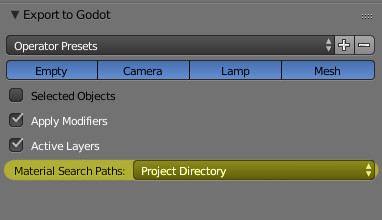Materials¶
Using existing Godot materials¶
One way in which the exporter can handle materials is to attempt to match the Blender material with an existing Godot material. This has the advantage of being able to use all of the features of Godot’s material system, but it means that you cannot see your model with the material applied inside Blender.
To do this, the exporter attempts to find Godot materials with names that match
those of the material name in Blender. So if you export an object in Blender
with the material name PurpleDots then the exporter will search for the
file PurpleDots.tres and assign it to the object. If this file is not a
SpatialMaterial or ShaderMaterial or if it cannot be found, then the
exporter will fall back to exporting the material from Blender.
Where the exporter searches for the .tres file is determined by the “Material
Search Paths” option:

- This can take the value of:
- Project Directory - Attempts to find the
project.Godotand recursively searches through subdirectories. Ifproject.Godotcannot be found it will throw an error. This is useful for most projects where naming conflicts are unlikely. - Export Directory - Look for materials in subdirectories of the export location. This is useful for projects where you may have duplicate material names and need more control over what material gets assigned.
- None - Do not search for materials. Export them from the Blender file.
- Project Directory - Attempts to find the
Export of Blender materials¶
The other way materials are handled is for the exporter to export them from Blender. Currently only the diffuse color and a few flags (eg unshaded) are exported.
Warning
Export of Blender materials is currently very primitive. However, it is the focus of a current GSOC project
Warning
Materials are currently exported using their “Blender Render” settings. When Blender 2.8 is released, this will be removed and this part of the exporter will change.